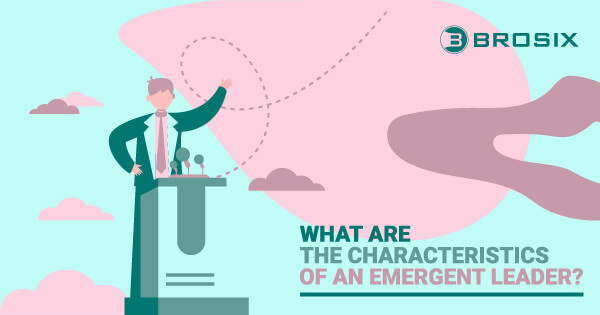If you’ve ever participated in a group activity (whether at school, work or elsewhere), you may have encountered people who naturally established themselves as leaders.
This is known as emergent leadership, a management structure in which an individual takes charge of a situation without the traditional organizational hierarchy.
Learning the characteristics and styles of emergent leaders may be beneficial as you pursue new job prospects.
This business model is increasingly common in today’s workspace as it allows leaders to grow naturally through their accomplishments and behavior.
In this article, we’ll go over emergent leadership’s role in the workplace, the traits an emergent leader exhibits, and the benefits it can bring to organizations.
What Is Emergent Leadership?
Еmerging leadership usually occurs when a group member becomes the leader through interactions with colleagues rather than being named or voted. The model relies on self-identified individuals instead of corporate hierarchy-selected leaders. In this business style, leaders develop over time through their ability to make decisions and achieve objectives.
Emergent leadership brings a plethora of benefits to organizations.
The main advantage is that it gives team members the freedom to make decisions that go against an organization’s conventional hierarchy.
Rather than waiting for permission from senior management, teams deploying emergent leadership can make operational decisions on their own and guide their teammates accordingly.
Leadership styles like this have become increasingly popular, motivating teams to think critically and creatively rather than following strict rules.
Emergent leaders, as opposed to officially appointed leaders, exhibit leaderlike influence and are looked up to by their peers.
Emergent Leadership Theories
Now that you’ve got an idea of what emergent leadership means let’s briefly look at the most influential theories that have shaped this business model.
The Social Identity Theory
The Social Identity Theory (SIT) developed by Michael A. Hogg suggests that a person being a group leader may have a lot to do with their personality.
According to this theory, individuals who become leaders are those who display the social identity of their followers’ prototypes.
Due to their similarity with the group’s prototype, emergent leaders are more attractive to the group.
Charismatic Leadership Theory
In the 1970s, several charismatic leadership theories emerged.
Charisma is a leadership trait through which individuals who possess it can persuade other members of a group to act swiftly and persistently.
It is a quality of a leader’s appeal that motivates others to support and accept them.
As a result, charismatic leadership is a kind of influence derived from the leader’s charisma.
Theory of Idiosyncrasy Credit
Social psychologists use the term “idiosyncrasy credit” to refer to a person’s ability to deviate from group expectations acceptably.
According to the Theory of Idiosyncrasy Credit proposed by Hollander, group members believe the person who takes the leadership position has lived up to their expectations.
The “contestants” who fulfill the demands of the group gain additional credits.
Because of these credentials, this hypothesis is reliant on leaders demonstrating their authority, which later gains acceptance.
Neo Emergent Theory
In Neo Emergent Theory, leaders are chosen for their ability to aid a team in reaching a goal.
The team determines who is a future leader based on how well that goal is accomplished and how each individual contributed to reaching that goal.
After an objective is achieved, leaders are acknowledged for their contribution.
What Are the Key Characteristics of Emergent Leaders?
Emergent leaders differentiate themselves from other types of leaders through specific personality traits.
To better understand the concept of emergent leadership, let’s take a closer look at the top 5 main characteristics emergent leaders usually have in common.
1. Self-motivated
Emergent leaders have intrinsic motivation to look for solutions and help others find solutions by asking questions and exchanging ideas.
They usually don’t need external rewards to drive them, as they are naturally motivated to solve issues.
They are the ones who stand up and offer a course of action. As self-starters, emerging leaders contribute to the development and upkeep of project momentum.
2. Creative thinkers
One primary characteristic that sets a person’s leadership potential apart in a group, is their ability to find alternative creative solutions to issues and generate new ideas.
Emergent leaders frequently do so because they speak up and offer the group fresh perspectives.
They are usually creative thinkers who come up with unique perspectives and don’t mind taking risks.
They demonstrate their leadership capabilities by offering suggestions to assist the team in resolving a problem so that a task can be completed.
3. Influential
As already mentioned, emergent leaders are influential because they look for feedback from others, which enables them to uphold their leadership credibility.
Due to their natural ability to generate solutions and new ideas, the other group members usually follow in the emergent leader’s footsteps.
4. Adaptable
Another crucial trait of emergent leaders that sets them apart from other team members is their adaptability to new and challenging situations.
Because they like taking risks and they’re creative thinkers, emergent leaders can adapt to any situation in the workplace.
This characteristic is extremely valuable, especially in fluid and dynamic workspaces, which are more common than ever.
5. Team-oriented
Last but not least, emergent leaders are not individualistic but rather team-oriented professionals.
They understand the importance of working together to achieve goals and objectives.
They also acknowledge that teams are essential for business success and recognize that they are a part of it rather than above it.
An emergent leader’s job is to encourage and inspire others to work in a way that will result in more efficient work-related solutions.
What Are the Differences Between Assigned and Emergent Leadership?
After going over the main characteristics emergent leaders have in common, it should be clear that they differentiate themselves from the group.
However, because every organization has assigned (also called nominal) leaders as well, it is important to notice the distinction between the two.
So, what are the main differences between nominal and emergent leaders?
Nominal leaders, as the name suggests, were appointed formal leadership positions by the organization.
On the other hand, emergent leaders are team members who become leaders over time as a result of how other group members see, treat, and respond to them.
While nominal leaders have influence over the group through their position, emergent leaders gain influence as a result of circumstances.
Over time, the influence of emergent leaders can turn out to be more powerful than those of assigned leaders.
Additionally, nominal leaders possess more task-oriented leadership traits, while emergent leaders possess greater social abilities.
The designated leader must demonstrate problem-solving abilities and the capacity to inspire other team members to justify their position.
On the contrary, emergent leaders usually demonstrate the same skills naturally. When emergent leaders arise, they gain the team’s respect because they’ve demonstrated their ability to work hard.
Employees might anticipate greater empathy from the emergent leadership approach than from the assigned leadership.
Why Should Organizations Encourage Emergent Leadership?
Promoting emergent leadership can bring plenty of benefits to organizations that adopt them at both individual and group levels.
When organizations encourage emergent leadership, they gain the massive advantage of knowing in advance of a promotion that a candidate can handle the position.
A self-motivated employee is one that keeps projects moving forward and produces successful outcomes.
On a more fundamental level, emergent leadership is the renewable energy source that fuels the productivity and expansion of the entire company.
Let’s explore the 5 core benefits organizations that cultivate emergent leaders have.
1. Fosters trust among team members
When professionals become leaders on account of their own merit through interactions with their peers, the leadership structure changes to one of mutual trust.
Employees will feel more included and appreciated in the decisions being made by a leader since emerging leadership is a more team-centric decision-making process.
They are more likely to believe the leader is looking out for their interests, which only increases team cohesion and trust within the group.
Teams that choose their own leaders rather than being forced to follow an assigned one are likely more invested in following that leader’s guidance.
2. Encourages independence
Employees in this structure are free to make decisions without seeking clearance from managers.
This business style enables emergent leaders to come up with the best solutions for their teams in the heat of the moment.
Naturally, when people are forced to follow an assigned leader, they are much more reserved in their actions.
However, when they choose their own leader based on that individual’s attitude and actions, they feel more comfortable making their own decisions.
3. Shifts the perspective
With this kind of management, the idea of a new leader entering the workplace and imposing their ideas about leadership is completely changed.
As a result of team interactions, leadership instead grows over time from within an organization. This way, leaders emerge organically.
This leadership style brings a whole new perspective to the traditional organizational hierarchy, eliminating the need for a top-down approach.
4. Stimulates a culture based on support
Organizations that practice emergent leadership foster a culture where team members are encouraged to take on leadership roles.
Because employees are given the freedom to self-govern their teams with leaders they help to choose, they also have the support of senior leaders.
This kind of management style cultivates a healthier company culture based on mutual trust, where all employees feel heard.
5. Enables ownership
The people with the biggest stake in the outcomes take charge of the situation in emergent leadership structures using their knowledge and ideas as an insider.
Since this approach focuses on agreement rather than a decree, it eliminates the bureaucracy of a top-down hierarchy that can cause delays in decision-making.
As emergent leaders are usually professionals who take ownership and pride in their work, this will only motivate other team members to do the same.
Final Thoughts
Assigned leadership is the business strategy most organizations use. Emergent leadership, though, might end up being more successful in the long run.
Unlike traditional leadership models based on hierarchical structures, emergent leadership is unique.
It enables workers to assume leadership roles without a structured hierarchy, and for this particular reason, it’s a leadership model not to be underestimated for business success.
Our ever-evolving workplace seems the ideal environment for emergent leadership.
Due to its immense benefits, it even has the chance to establish itself as the standard organizational model in the future.
However, for such a leadership style to be able to develop, organizations must make a commitment to fostering positive company culture.











